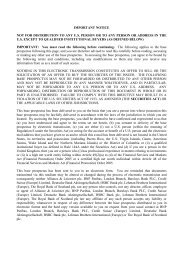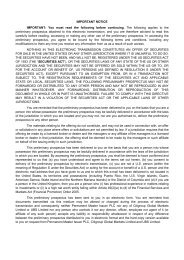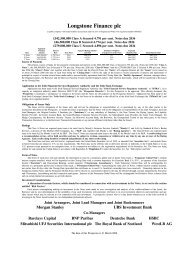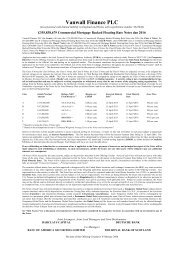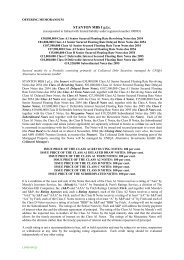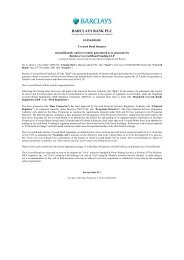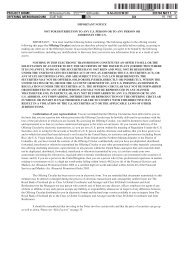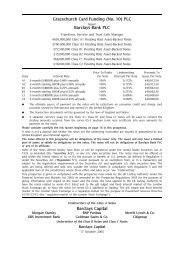Offering Circular. - SFM
Offering Circular. - SFM
Offering Circular. - SFM
Create successful ePaper yourself
Turn your PDF publications into a flip-book with our unique Google optimized e-Paper software.
Pursuant to Law No. 20 of 14 January 1994 as amended, the Court of Accounts (Corte dei Conti), an<br />
administrative and local finance court, exercises supervisory powers on the operations of the regions and, in<br />
particular, on the achievement of the principle targets established by the Federalism Law. The Corte dei Conti<br />
also monitors the accounting procedures of the regions (giurisdizione contabile), including compliance of<br />
employees of the Region with such accounting procedures.<br />
Pursuant to Legislative Decree No. 286 of 30 July 1999, regions were required to establish supervisory<br />
bodies for internal control purposes, such as (a) control on administrative and accounting procedures and<br />
compliance (controllo di regolarità amministrativa e contabile); (b) control on management activity<br />
(controllo della dirigenza); (c) strategic control, which consists in an evaluation of consistency between<br />
predetermined targets and results (valutazione e controllo strategico); and (d) control on operations<br />
(controllo di gestione).<br />
The Region of Lazio has implemented such internal control procedures.<br />
Prior to the enactment of the Federalism Law, and in keeping with the Central Government’s tendency to<br />
grant greater autonomy to the regions, the Central Government enacted the so-called Legge Bassanini (Law<br />
No. 59 of 15 March 1997, as amended).<br />
Pursuant to the Legge Bassanini, certain legislative and administrative powers previously exercised by the<br />
Central Government are devolved to regions in a three-step process:<br />
(i)<br />
(ii)<br />
enactment by the Central Government of legislative decrees assigning new powers to the regions;<br />
implementation of the legislative decrees through the enactment of regional laws which also have the<br />
purpose of transferring certain powers to the provinces and municipalities; and<br />
(iii) transfer and assignment by the Central Government to the regions of the operating and financial<br />
resources to support and fund the new functions through decrees of the Prime Minister.<br />
Several legislative decrees were enacted which devolve to the regions certain administrative powers<br />
contemplated by the Legge Bassanini including those relating to agricultural, labour, transport, trade, crafts,<br />
industry, energy, mines, geothermal and water resources, fairs and markets, tourism, chambers of commerce,<br />
environment, city planning, public works, roads, healthcare, social services, public education, sports, shows,<br />
local and regional police. In particular, Legislative Decree No. 112 of 31 March 1998 transferred to the<br />
regions several functions, of which the most important concern financial resources, productive activities,<br />
transports, environment, healthcare. Certain decrees of the Prime Minister have been enacted to transfer<br />
funds and personnel to the regions in support of the new functions. The Region has received the funds<br />
contemplated by Legge Bassanini since the year 2000.<br />
Currently, a reform is being reviewed by the Parliament which may have further effects on the transfer of<br />
powers, in particular regarding the areas of education, local police and healthcare.<br />
Regional Administration<br />
Local Government. The Region of Lazio, like all ordinary Italian regions, is managed by a Regional Council<br />
(Consiglio Regionale), a Regional Board (Giunta Regionale) and a Regional President (Presidente della<br />
Regione) who is also chairman of the Regional Board. Regional Councils typically have legislative and<br />
regulatory functions and are composed of between 30 and 80 Regional Councillors (Consiglieri Regionali),<br />
depending on the population of the region that they represent. Lazio’s Regional Council is composed of 60<br />
Regional Councillors. The electoral system provides that 80 per cent. of the Regional Councillors be elected<br />
from provincial lists in exact proportion to the votes received by the political parties to which the candidates<br />
belong. The remaining 20 per cent. of the Regional Councillors are elected by constituents on a majority<br />
basis. Elections are held every five years.<br />
The Regional Council has responsibility for the Region of Lazio’s policy and regulation. In particular, the<br />
Regional Council is responsible, inter alia, for approving the regional by-laws and regional laws (for the<br />
matters of competence of the Region of Lazio), for the Region’s accounts and budgets, for the Region’s<br />
40



